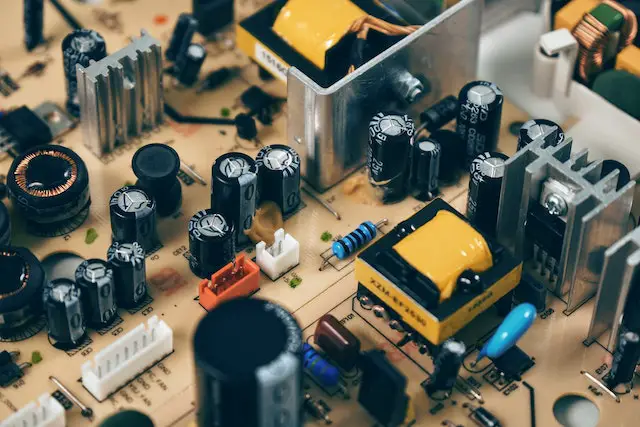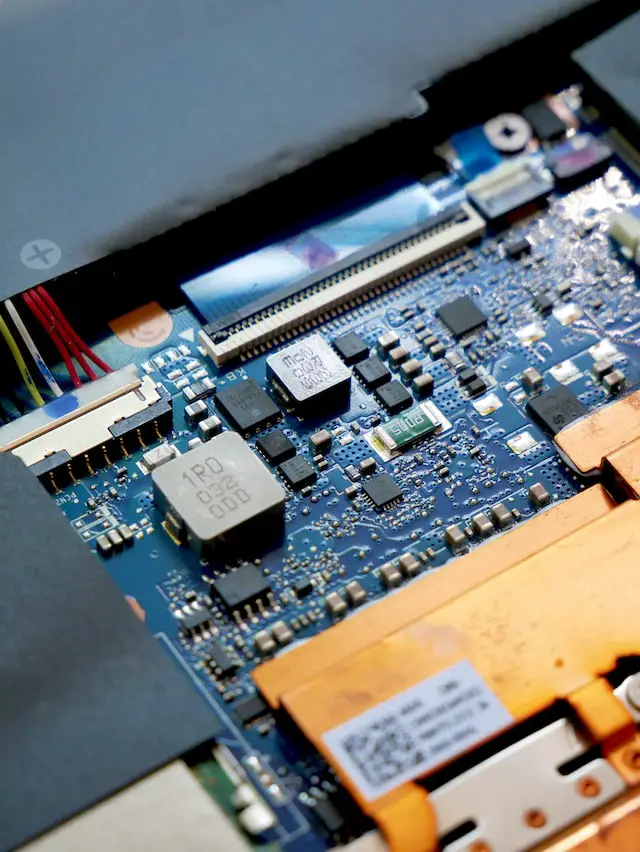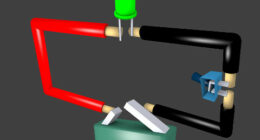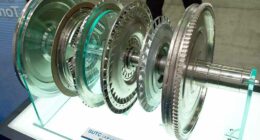Capacitors store energy in the form of an electric field, while inductors store energy in the form of a magnetic field. Both types of devices are used in electronic circuits to control the flow of electricity.
What is a capacitor?
(Photo by Pixabay )

A capacitor is an electronic component that stores electrical energy in an electric field. It is commonly used in various electronic devices and electrical circuits. The capacitor is designed to store and release electrical charge when needed, providing temporary energy storage and filtering in electrical systems.
Here are the key features and characteristics of a capacitor:
- Construction: A typical capacitor consists of two conductive plates separated by a dielectric material. The conductive plates are usually made of metal, such as aluminum or tantalum, while the dielectric material can be made of various materials like ceramic, plastic, or electrolyte.
- Capacitance: The capacitance of a capacitor is a measure of its ability to store electrical charge. It is determined by factors such as the surface area of the plates, the distance between them, and the properties of the dielectric material. Capacitance is measured in farads (F), although capacitors used in everyday applications are typically rated in microfarads (μF), nanofarads (nF), or picofarads (pF).
- Charging and Discharging: When a voltage difference is applied across the terminals of a capacitor, it starts to charge. The charge accumulates on the plates, creating an electric field between them. Once the capacitor is fully charged, it can hold the stored energy until it is discharged or connected to a circuit where the energy can be used.
- Energy Storage and Release: Capacitors store electrical energy in the electric field between the plates. They can quickly release this stored energy when connected to a circuit, providing a burst of power or compensating for fluctuations in voltage or current. Capacitors are often used in conjunction with other components to stabilize power supplies, filter out unwanted signals, or store energy for specific applications.
- Applications: Capacitors have numerous applications in electronic circuits and devices. They are used in power supply circuits, electronic filters, timing circuits, motor starting circuits, audio systems, communication equipment, and many other electronic systems. Different types of capacitors with varying properties and characteristics are available to suit different application requirements.
- Capacitor Types: There are various types of capacitors, each with its own characteristics and applications. Some common types include electrolytic capacitors, ceramic capacitors, film capacitors, tantalum capacitors, and polyester capacitors. Each type has its advantages and limitations in terms of capacitance range, voltage rating, temperature stability, size, and cost.
Capacitors play a vital role in electronic circuits, providing energy storage, filtering, and other functions necessary for proper circuit operation. They are widely used in a broad range of electronic devices, from small consumer electronics to complex industrial systems.
What is an inductor?
(Photo by Nothing Ahead)

An inductor is an electronic component that stores energy in a magnetic field when an electric current flows through it. It is commonly used in electrical circuits for various purposes, such as energy storage, filtering, and inductive load control.
Here are the key features and characteristics of an inductor:
- Construction: An inductor is typically constructed using a coil of wire wound around a core made of a magnetic material. The coil can have many turns to increase the inductance. The magnetic core material, such as iron or ferrite, enhances the inductor’s ability to store magnetic energy.
- Inductance: Inductance is the measure of an inductor’s ability to store energy in a magnetic field. It is determined by factors such as the number of turns in the coil, the coil’s shape and dimensions, and the magnetic properties of the core material. Inductance is measured in henries (H), although smaller values such as millihenries (mH) or microhenries (μH) are commonly used.
- Magnetic Field Storage: When an electric current flows through an inductor, a magnetic field is generated around the coil. This magnetic field stores energy, and the strength of the field is directly proportional to the current flowing through the inductor. The magnetic field collapses and releases the stored energy when the current changes or the inductor is disconnected from the power source.
- Inductive Reactance: Inductors exhibit a property called inductive reactance, which is the opposition to the change in current flow. Inductive reactance increases with higher frequencies, meaning that inductors are more effective at blocking or attenuating high-frequency signals.
- Applications: Inductors have various applications in electronic circuits. They are used in power supplies, filters, oscillators, transformers, motors, antennas, and many other electronic systems. Inductors are particularly useful in applications where energy storage, voltage regulation, or filtering of electrical signals is required.
- Inductor Types: Different types of inductors are available to suit specific circuit requirements. Common types include air-core inductors, iron-core inductors, toroidal inductors, and surface mount inductors. Each type has its own characteristics in terms of inductance value, current-carrying capacity, size, and frequency response.
Inductors are essential components in electrical circuits, allowing for energy storage, current control, and frequency filtering. They play a significant role in various electronic devices, from small electronics like smartphones and computers to large-scale applications in power systems and industrial equipment.
Capacitor Vs Inductor – Key differences
Capacitor:
- Stores electrical energy in an electric field.
- Composed of two conductive plates separated by a dielectric material.
- Capacitance is a measure of its ability to store charge.
- Charges and discharges based on the voltage across its terminals.
- Used for energy storage, filtering, and voltage regulation in circuits.
- Can release energy quickly when connected to a circuit.
- Different types include electrolytic, ceramic, film, and tantalum capacitors.
- Measured in farads (F), often rated in microfarads (μF) or picofarads (pF).
Inductor:
- Stores energy in a magnetic field.
- Consists of a coil of wire wound around a magnetic core.
- Inductance is a measure of its ability to store magnetic energy.
- Reacts to changes in current flow and opposes it.
- Used for energy storage, filtering, and inductive load control.
- Releases stored energy when the current changes or it is disconnected.
- Different types include air-core, iron-core, toroidal, and surface mount inductors.
- Measured in henries (H), often rated in millihenries (mH) or microhenries (μH).
While both capacitors and inductors store energy, they do so in different ways and exhibit distinct characteristics in electronic circuits. Capacitors store energy in an electric field, while inductors store energy in a magnetic field. Their behavior and applications vary, with capacitors commonly used for energy storage and filtering, and inductors for energy storage and inductive load control.
How do capacitors and inductors work?
Capacitors and inductors work based on different principles and have distinct behaviors in electrical circuits:
Capacitor:
- A capacitor stores electrical energy in an electric field between its two conductive plates separated by a dielectric material.
- When a voltage is applied across the terminals of a capacitor, it charges and accumulates electrical charge on its plates.
- The charge on the plates creates an electric field between them, and the capacitor stores energy in this field.
- The amount of charge that can be stored (capacitance) depends on the surface area of the plates, the distance between them, and the properties of the dielectric material.
- Capacitors can release the stored energy quickly when connected to a circuit, providing a burst of power or compensating for voltage fluctuations.
- They are commonly used for energy storage, voltage smoothing, filtering out unwanted signals, and as timing components in circuits.
Inductor:
- An inductor stores energy in a magnetic field generated when an electric current flows through it.
- It consists of a coil of wire wound around a magnetic core material, which enhances the inductor’s ability to store magnetic energy.
- When current flows through the coil, a magnetic field is created around it, and the inductor stores energy in this field.
- The amount of energy stored (inductance) depends on factors such as the number of turns in the coil, the coil’s dimensions, and the magnetic properties of the core material.
- Inductors react to changes in current flow, resisting the change by generating a voltage that opposes the current (inductive reactance).
- When the current changes or the inductor is disconnected from the power source, the magnetic field collapses, releasing the stored energy.
- Inductors are commonly used for energy storage, inductive load control, filtering out high-frequency signals, and in applications like transformers, motors, and oscillators.
Capacitors store energy in an electric field between plates, while inductors store energy in a magnetic field generated by a current-carrying coil. Capacitors release energy quickly, while inductors resist changes in current flow. Their distinct behaviors make them useful in various applications within electrical circuits.
Photo by Vishnu Mohanan on Unsplash








